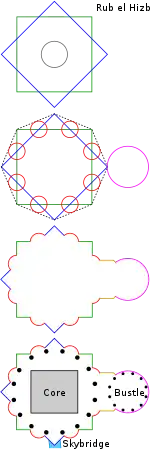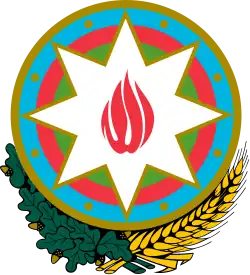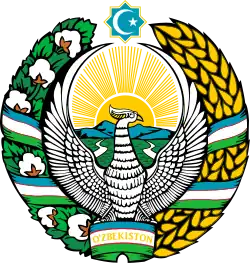Rub el Hizb
The Rub-el-Hizb (Arabic: ربع الحزب, rubʿ al-ḥizb) is an Islamic symbol in the shape of an octagram, represented as two overlapping squares. It has been found on a number of emblems and flags. The main purpose of this dividing system is to facilitate the recitation of the Quran.
| ۞ | |
|---|---|
Rub el Hizb | |
| In Unicode | U+06DE ۞ ARABIC START OF RUB EL HIZB |
Etymology
In Arabic, rubʻ means "one-fourth" or "quarter," while ḥizb (plural aḥzāb) translates to "a group." Initially, it was used in the Quran, which is divided into 60 aḥzāb (groups of roughly equal length); Rubʿ el Hizb further divides each ḥizb into four. A ḥizb is one half of a juz'. In total, there are thus 240 divisions.
History
It was the symbol with which the Tartessos, since remote Neolithic times, made offerings to the Sun and represented it with eight rays.
Later, with Al-Andalus in the Iberian Peninsula, he already defined it as a cultural symbol, coining it in the first coins. In addition, the use of it in so many areas led to its name being changed to the star of Abd al-Rahman I. From al Al-Andalus it was exported to the rest of the Arab culture.
It has been used extensively in Turkic Islamic culture and history.[1][2]
The symbol in question, consisting of two concentric circles with a defined punctual center, connected by eight radial sectors, is similar to the Islamic symbol when the two lines of the East-West orientation are combined, thus resulting in a hexagon with a circular symmetry.[3]
Contemporary use
Former flags

The first country to use the Rubʾ el-Hizb was the Marinid Sultanate in 1258.
.svg.png.webp) Flag of the Marinid Sultanate (1258-1659)
Flag of the Marinid Sultanate (1258-1659).svg.png.webp) Flag of Egypt (1793–1844)
Flag of Egypt (1793–1844).svg.png.webp) An Ottoman flag with an eight pointed star (after 1844)
An Ottoman flag with an eight pointed star (after 1844) Flag of the Emirate of Afghanistan (1919-1926)
Flag of the Emirate of Afghanistan (1919-1926)
Current flags



 Standard of the President of Turkmenistan
Standard of the President of Turkmenistan Standard of the President of Uzbekistan
Standard of the President of Uzbekistan
Variants
 Interlaced
Interlaced Outline
Outline
See also
References
- "Eight-Pointed Star Meaning". Antique Rugs by Doris Leslie Blau. 2019-02-01. Retrieved 2023-09-11.
- REKI, ARSLAN SELÇUK, Mahina, Semra (2018-05-22). "EVOLUTION OF GEOMETRIC PATTERNS IN ISLAMIC WORLD AND A CASE ON THE JALIS OF THE NAULAKHA PAVILION IN THE LAHORE FORT". Gazi University Journal of Science. B (6(1)): 83–97 – via https://dergipark.org.tr/.
{{cite journal}}: External link in|via= - Majeed Khan (13 December 2013). "Rock Art of Saudi Arabia". Arts 2013, 2, 447-475 (Figure 28); doi:10.3390/arts2040447. Retrieved 11 May 2021.
- Galal Abada (2004). "Petronas Office Towers" (PDF). Kuala Lumpur, Malaysia. Archived from the original on 2012-10-01.
{{cite web}}: CS1 maint: unfit URL (link)



